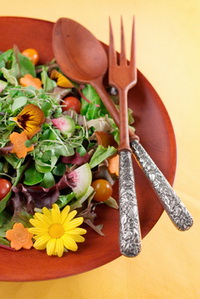Eatable Flowers FAQ

Eatable flowers are a subject that come up in almost all cooking classes eventually and I am a big fan of them. In order to cook with them safely however, a little bit of knowledge is required. A single article could not hope to describe the entire variety of eatable flowers and their uses but most people generally ask the same questions when they are new to the subject and I will now outline the answers to those questions.
Eatable Flowers FAQ 1: What are Eatable Flowers Used For?
Eatable flowers are used for a variety of aesthetical purposes in cooking as well as for flavour. One of their primary uses, particularly in Asian and Middle Eastern cooking is to add colour to dishes that primarily contain eggs, rice or milk and therefore lack colour. They are also used as edible decorations and garnish on many dishes, particularly those served in upscale restaurants where the importance of aesthetics increases in cooking ten fold. As for flavour, one common use is to soak them in milk and then add them to cakes and breads. They are also of course used in a variety of oils, dressings and marinades to enrich and deepen the flavour provided. They are also particularly useful when stuffing various meats.
Eatable Flowers FAQ 2: Are Eatable Flowers Safe?
In my opinion this is probably the most important eatable flower FAQ of them all, as not understanding the answer can prove fatal. Humans have eaten flowers right from the beginning of our existence, however there is still very real dangers, perhaps even more so nowadays. Many flowers are toxic, even those that are contained in peoples back gardens. It's important to remember also that many breeds of flowers look almost identical, so be very careful when attempting to identify them.
Eatable Flowers FAQ 3: What about Pesticides?
As well as being careful what eatable flowers you consume, it is also very important to consider the possibility that they have been sprayed with pesticides. Many that would easily fit into the eatable category are sprayed with pesticides that render them poisonous. Therefore never eat flowers that you find yourself unless you understand both which ones are toxic and how to safely prepare them and you are sure they have not been sprayed with pesticides. If you eat those that have been purchased, always ensure that they have been sold with the intention that they will be eaten.
Eatable Flowers FAQ 4: What Are the Most Popular Eatable Flowers?
The most commonly eaten eatable flowers include rose petals, chives, mint and sage. They are the most popular due to their unique and strong flavours. Other less well known but equally delicious eatable flowers include lilac and dianthus. If you are looking for eatable flowers specifically for their vitamin values, a lot of vitamin C can be found in marigolds and nasturtiums. Dandelion blossoms on the other hand are very rich in vitamin A.
So in conclusion, eatable flowers are a great addition to any aspiring chef's capabilities. Provided you take the necessary precautions they can lead to both healthy and delicious meals.
The internet has a lot of information about the many types of eatable flowers out there and provided you are careful, experimenting with the different types is a great way to find new flavours for your favourite dishes.
